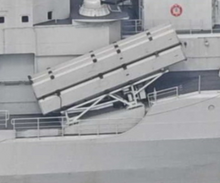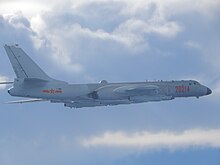YJ-12
| YJ-12 | |
|---|---|
 YJ-12A anti-ship missile launcher | |
| Type | Anti-ship cruise missile |
| Place of origin | China |
| Service history | |
| In service | c.2011–present |
| Used by | |
| Production history | |
| Manufacturer | China Aerospace Science and Industry Corporation (CASIC) |
| Specifications | |
| Warhead | 205–500 kg (452–1,102 lb)[1][2] |
| Engine | integrated ramjet/booster propulsion system[3] |
Operational range | 250–270 nmi (290–310 mi; 460–500 km) |
| Maximum speed | Mach 2.5 to 4 |
Guidance system | BeiDou satellite navigation with mid-course updates, terminal active radar homing |
Launch platform |
|
The YJ-12 (Chinese: 鹰击-12; pinyin: yīngjī-12; lit. 'Eagle Strike 12') is a Chinese supersonic anti-ship cruise missile[4][5] manufactured by China Aerospace Science and Industry Corporation (CASIC).[6]
Description
[edit]
The YJ-12 resembles a lengthened Kh-31.[3] According to the United States, the air-launched (YJ-12) and ship-launched (YJ-12A) variants have 270 nmi (310 mi; 500 km) ranges.[4][5] Speeds of Mach 2.5[3] to 4[1] have been reported. The YJ-12 may perform evasive maneuvers to avoid anti-missile threats.[7]
According to War on the Rocks, a ship has 45 seconds to engage a YJ-12 after sea-skimming missile appears over the horizon and is detected. In 2014, the United States Navy (USN) intended to counter air-launched YJ-12 saturation attacks by destroying Chinese strike aircraft at long range before the missiles are launched; the tactic relies on Cooperative Engagement Capability.[8]
Development
[edit]In August 2000, the Chinese unveiled a model of an air-launched missile labeled as the YJ-91, resembling the French Air-Sol Moyenne Portée. Later, a similar-looking missile was seen that may have been designated as the YJ-12. The YJ-91 designation ultimately went to the Chinese development of the Russian Kh-31.[9]
Externally, the YJ-12 resembled a lengthened Kh-31.[3]
The YJ-12 appeared at the 2015 China Victory Day Parade,[10] indicating that the missile had entered active service since all weapons showcased during the parade are actively inducted prior to the parade.[11]
The YJ-12A was reportedly in development in 2014.[9] The YJ-12A entered service around 2020 aboard refitted Type 051B and Sovremenny-class destroyers of the People Liberation Army Navy.[12]
The YJ-12B was reportedly deployed to the Spratly Islands around April 2018.[13] They may cover the southern half of the South China Sea when based on three largest Chinese-controlled islands.[14]
Variants
[edit]- YJ-12
- Air-launched variant with a 270 nmi (310 mi; 500 km) range.[5]
- YJ-12A
- Ship-launched variant with a 270 nmi (310 mi; 500 km) range.[4]
- YJ-12B
- Land-based variant with a 250 nmi (290 mi; 460 km) range.[14]
- CM-302
- Export variant. According to the China Aerospace Science and Industry Corporation, it is an anti-ship and land-attack missile with a 280 km (170 mi; 150 nmi) range, a 250 kg (550 lb) warhead, and launched from air, land, and naval platforms The missile uses BeiDou satellite navigation, with active radar terminal guidance; the target may be updated by data-link.[15]
Operators
[edit]Current operators
[edit]- Algerian National Navy, CM-302 (land-based)[16]
- Pakistan Navy, CM-302 (ship-launched)[17]
See also
[edit]Related development
Comparable missiles
- 3M-54 Klub – (Russia)
- BrahMos – (Russia, India)
- P-800 Oniks – (Russia)
- Future Cruise/Anti-Ship Weapon – (France, Italy, United Kingdom)
- ASM-3 – (Japan)
- Yun Feng – (Taiwan)
References
[edit]- ^ a b Renjie, Guo, ed. (4 February 2015). "China's anti-ship missiles YJ-12 and YJ-100 revealed". China Military Online. Archived from the original on 11 February 2015. Retrieved 13 June 2015.
- ^ "Pradun: From Bottle Rockets to Lightning Bolts, p.14". Archived from the original on 2016-03-04. Retrieved 2015-05-21.
- ^ a b c d Gormley, Dennis M.; Erickson, Andrew S.; Yuan, Jingdong (30 September 2014). "A Potent Vector: Assessing Chinese Cruise Missile Developments". Joint Forces Quarterly (75). National Defense University: 102. Retrieved 8 May 2015.
- ^ a b c d Military and Security Developments Involving the People's Republic of China 2023, p. 57.
- ^ a b c Military and Security Developments Involving the People's Republic of China 2023, p. 58.
- ^ "震撼:中国3大军工巨头在航展上竟展示如此多新导弹". Sina News. 9 November 2016.
- ^ Minnick, Wendell (August 8, 2017). "China Puts Guam Within Missile Range". Defense News.
- ^ Haddick, Robert (2 July 2014). "China's Most Dangerous Missile (So Far)". War on the Rocks. Retrieved 19 May 2015.
- ^ a b "YJ-91/YJ-12 (China), Offensive weapons". janes.com. Archived from the original on 2 February 2010. Retrieved 15 May 2015.
- ^ Fisher, Richard D. Jr. (4 September 2015). "China showcases new weapon systems at 3 September parade". IHS Jane's 360. Retrieved 11 December 2015.
- ^ "陈士强:抗战胜利70周年纪念活动充分展示我军战斗力--军事--人民网". military.people.com.cn. Retrieved 2015-12-13.
- ^ Sutton, H.I. (1 May 2020). "China Increases Potency Of Anti-Carrier Capabilities". Forbes. Retrieved 30 June 2024.
- ^ Macias, Amanda (May 2, 2018). "China quietly installed defensive missile systems on strategic Spratly Islands in hotly contested South China Sea". CNBC.
- ^ a b Stashwick, Steven (14 June 2018). "China deploys anti-ship missiles on islands in the South China Sea". The Diplomat. Retrieved 10 March 2023.
- ^ Tate, Andrew; Gibson, Neil (9 November 2016). "China offers export version of YJ-12 supersonic anti-ship missile". Jane's Information Group. Archived from the original on 12 November 2016. Retrieved 21 November 2016.
- ^ The Military Balance 2024, p. 344.
- ^ The Military Balance 2024, p. 302.
- ^ The Military Balance 2024, p. 260.
- Bibliography
- The International Institute for Strategic Studies (13 February 2024). The Military Balance 2024. London: Routledge. ISBN 978-1-032-78004-7.
- Pradun, Vitaliy O. (Spring 2011). "From Bottle Rockets to Lightning Bolts: China's Missile Revolution and PLA Strategy against U.S. Military Intervention". Naval War College Review. 64 (2). United States Naval War College. Archived from the original on 4 March 2016. Retrieved 19 May 2015.
- United States Office of the Secretary of Defense (19 October 2023). Military and Security Developments Involving the People's Republic of China (PDF) (Report).
